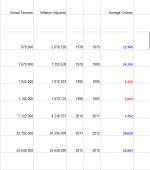Imagine having to write out a cheque for £93,284 on the first day of the year, waking up the following morning and doing the same, and going through that Groundhog Day experience for the full 366 days of the 2015/16 football season.
That’s what Tony Bloom effectively did for the Albion last season. The club has just announced losses of £25.9 million for the year ended 30 June 2016, compared to £10.4 million the previous season.
However, TB did more than that cover the losses, he lent the club over £34 million in the same period, to take his total investment (in both shares and loans) to just under £252 million.
We’ve taken a look at the accounts in detail, and, thanks to a very old pile of documents coming our way, can compare the financial machine that is the Albion today to some of the pivotal moments in the club’s history.
What becomes increasingly evident is that the normal rules one would apply when assessing a business do not apply in the Championship.
Income
Football clubs get their money from three main sources fans (matchday), TV and radio (broadcasting) and commercial deals/advertising.


Matchday income
A look at the Albion over the last three seasons reveals that matchday income at the Amex appears to have reached a plateau.
The club froze most prices for matches and season ticket holders, and therefore were reliant on either higher attendances or more matches to increase income.
Whilst the football and results from the Albion in 2015/16 were incredible, there was a fan hangover from the previous season, where the club came close to relegation.
Despite the improvement in the quality of football, tickets sold for each game at the Amex fell, albeit by only 0.3%, to 25,583.
Whilst I suspect that tickets for individual matches rose, as more casual fans chose to watch the Albion, this was offset by a reduction in season ticket renewals from 2014/15.
Add to that a reduction in the number of matches hosted at the Amex due to early cup exits, and that results in the fall in matchday income.
The importance of matchday income is shown above. It generates half of the Albion’s turnover, to put this in context, this figure can be as low as 9% for clubs in the Premier League.
This shows the importance of getting both the pricing and the product to the Albion board, as fans contributions are significant. Issues such as transport and catering are ongoing challenges as they act as deterrents to some fans when deciding whether or not to attend individual matches.
One problem in relation to matchday income is that the Amex is effectively only open for 25 days a year in terms of earning money, whereas many costs, such as staff wages, are borne 365 days a year.
This current season (2016/17) the Albion’s great start to the season means they are currently averaging 26,931 fans at the Amex.
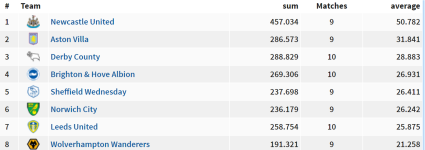
We’ve estimated that the club generates an average £18 from each additional matchday ticket sold (remember the club has to pay VAT to the government at 20% and also pay for the travel cost, which is probably £3 per ticket. In addition, some tickets will be sold to concessions, so quoted matchday prices need to be adjusted).
The extra 1,348 tickets being sold each match, over (say) 24 matches at the Amex this season, will therefore generate about £580,000 of extra income. This is equivalent to what Tony Bloom lent to the club in less than a week last season.
Broadcasting income
In the Premier League (EPL) the vast majority of turnover for a provincial club against which the Albion would logically benchmark themselves (Stoke, Swansea, West Brom etc.) comes from TV deals. This can account for up to 80% of turnover.
The new Sky/BT deal covering domestic rights for three seasons commencing 2016/17 is worth over £5,100,000,000 and overseas rights add a further £3 billion to that total, with new deals (such as China) being announced on a regular basis.
This meant that EPL clubs in 2015/16 received a minimum of £66 million, which is set to increase to a minimum of £99 million in 2016/17.
In addition, teams relegated from the EPL are set to receive parachute payments of about £40 million a season, which is why the Albion are at a considerable disadvantage competing against such clubs.
This means promotion is becoming more critical season by season, as parachute payments increase the probability of clubs relegated from the EPL swiftly bouncing back.
The deal signed by the English Football League (EFL) for broadcasting is miniscule compared to the EPL. The Albion’s money is effectively split between a ‘solidarity’ payment from the EPL (which is set to rise in 2016/17 as a side benefit of the new EPL deal) and the distribution of rights for the 72 clubs in the EFL.
The chasm between the two deals is simply due to commercial reasons. Both domestic and overseas armchair fans want to watch ‘big’ teams such as Manchester United, Liverpool and Chelsea. We have to be honest and admit there is limited demand from both viewers and sponsors for Birmingham v Brighton at 5:30 on a Saturday night in December.
Commercial income
I have lumped in with sponsorship deals things such as women’s football, catering/events (the Albion had an effective £400,000 benefit from showing the Rugby Football World Cup last Autumn) and other sundry issues.
For a club the size of the Albion, commercial deals are worth about a quarter of total income. There has been little change from 2015 to 2016 simply because most deals are spread over a number of years.
Furthermore, the poor season in 2014/15 meant that the Albion were not a very attractive prospect for sponsors for the following year, so it would have been difficult to extract extra cash from this source.
Summary
Overall the Albion have done well to increase income, but the disadvantages they have in not receiving parachute payments gives further credence to their efforts to expand income streams through ventures such as the hotel at Falmer.
Wages
It’s no surprise to learn that the main costs of a football club are wages. Tony Bloom backed Chris Hughton last season by agreeing to sign players (see later) and pay them competitive wages for the Championship.
The most striking figure is that the total wages cost rose about a third compared to 2015 to a total of £27.4 million. This means that for every £100 of income generated by the club, they paid out £111 in wages.
This should not however be a huge surprise when you consider that the club signed Hunemeier, Hemed, Skalak, Goldson, Murphy, Knockaert and Manu for significant fees. If you pay large fees for players, then they expect commensurate wages.
In addition the Albion rebuffed Fulham’s £5 million plus bid for Lewis Dunk by granting him a new contract, and this would have come with a significant pay rise as a reward for him staying.
The return of Bobby Zamora would also have increased the wage bill. Whilst Bobby would have been on a fraction of his Premier League wages from earlier in his career, he still would have expected a decent reward for a player of his experience at the top level of football.
Championship wages are high these days for two reasons. Whilst it would be impossible to come close to matching what could be offered by a top level EPL team (the Albion’s total wage bill for all 270 full time employees is approximately equal to what Manchester United pay to the combined earnings of Rooney and Ibrahimovic), the club needs to be able to resist overtures from lower level EPL teams and Championship clubs awash with parachute payments for their star players.
In addition, Championship clubs are willing to spend big because the rewards of promotion are so high. The extra £100 million a season for each season in the EPL is very attractive to club owners, and in some ways is like a winning lottery ticket. However, instead of having a 1 in 140 million chance as you and I have of winning on the National Lottery, there is a 3 in 24 chance of being promoted at the start of each season to win this £100 million. Under those circumstances club chairmen are willing to pay a lot for a ticket to win the prize.
If you think that the Albion wage total is high, then just wait for Middlesbrough to announce their results. They were supposedly paying Downing £50,000 a week and Jordan Rhodes would be on something similar following his £9 million move in January. It was only 18 months ago that Adam Clayton rejected a move to the Albion because ‘Boro had offered him more money. Boro’s wage bill in 2015 was slightly lower than that of the Albion at £20.5 million but I would anticipate this reversing in 2016.
The Championship in 2016 is thus a totally different beast to when the Albion were promoted in 1978/79 to the top division. That season the highest paid player was on £350 a week and the total wage bill at the club was £442,000, less than what the average first team squad member is on at present at the Albion.
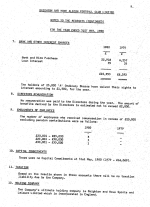
Over the 37 years since the Albion were promoted to the old first division in 1978/9, wages have grown by 6,095%.
It would be remiss of us at this stage to not mention executive pay. In any other industry, if a new chief executive was recruited on a salary 3-4 times that of his predecessor, and under the first four years of his tenure delivered record losses of £62 million, then there would be eyebrows raised.
However, as has been mentioned before, Championship level football is not an ordinary business. Paul Barber has been responsible for cutting non-football related costs during this period, and this has enabled the club to stay within Financial Fair play limits.
For this reason his pay is fair as he’s delivered cost savings and allowed managers to have a higher playing budget. In addition the highest paid CEO’s in the EPL are on more than £2 million a year, so Tony Bloom has to pay a significant amount to be competitive.
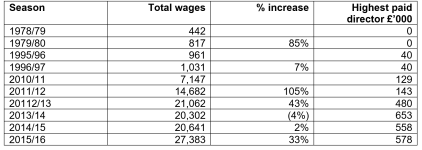
Eagle eyed fans amongst you will note that David Bellotti was paid £40,000 a year during the final years of the Goldstone. Whilst it is usually wrong to speak ill of the dead, in this case we’re sure an exception is appropriate. Bellotti was responsible for selling the Goldstone for £7 million, and then saw it sold within 12 months for three times that sum.
Losses
Profits and losses are abstract accounting concept, but, put simply, is income less costs. We have slightly tweaked the way the club has set out the numbers simply to strip out the volatile impact of player sales.
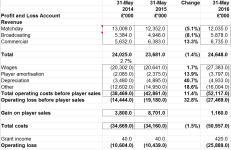
Some of the costs above require further explanation. Player amortisation is how clubs deal with transfer fees in terms of impact on profit. If (for example) Shane Duffy cost the club £3.6 million and signed a four-year contract, then £900,000 amortisation (£3.6m/4) is charged against profits for the next four seasons.
The increase of 60% in this figure between 2015 and 2016 reflects the investment in the playing squad. Some players contracts are not amortised. Those who have come through the youth system, such as Dunk and March, and players who have signed on free transfers, such as Zamora, will not have any impact on this total.
Depreciation is similar to amortisation, but relates to the cost of the Amex, the Lancing training facilities and other long term assets. These are not cash costs, but is merely something to keep the accountants happy in spreading the cost of the stadium over the expected period of use.
One area the senior management team focus a lot of time on is cost control. Staff numbers for non-players were static between 2015 and 2016, so it looks as if there is some form of head count control.
If the club can reduce non-footballing costs, then there is more money available to spend on the playing budget. So the club take a very intense line by line approach to all costs, so see if there is scope for savings.
One figure that is significant above is the gain on player sales. If fans are scratching their heads to work out how we sold a player at a profit in 2015/16, the answer is almost certainly Leo Ulloa, despite him leaving the Albion in July 2014.
This is because it appears the club had a clause in the sale contract along the lines of Leicester paying the Albion an extra sum should Leicester avoid relegation in 2015/16, which they of course did with some elan. The gain of £8.7 million in 2014/15 is due to the sales of Leo Ulloa and Will Buckley at prices significantly higher than their value in the accounts.
So although last season (2014/15) the Albion announced a loss of £10.4 million, this was understating their day to day trading losses, which came out at £19.1 million if the player sales were excluded. I think this is a better reflection of the performance as gains on player sales are windfalls and very difficult to budget for.
Total costs, before gains on player sales, therefore topped £52 million, which means that the Albion’s running costs are exceeding £1 million a week.
The increase in losses from 2015 to 2016 can therefore be reconciled as follows:

To give some historical perspective, when the Albion were promoted in 1978/79, they made a profit of £296,000.
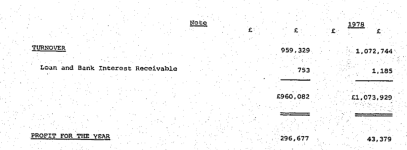
Player investment
In 2015/16 Burnley, awash with parachute payments, spent at least £7 million on one player, Andre Gray. Boro, who as we’ve already mentioned, went for broke and bought Rhodes for somewhere between £9-11 million, Downing for £5.5m, Nugent £4m, Stuani £3.5m, a total spend of around £25 million.
The Albion’s total player purchases, whilst a record for the club, came to £9.15 million, spread over a number of purchases.
Whilst the club prefer to keep transfer fees as ‘undisclosed’ in the main, we’ve come up with a rough and ready allocation as follows
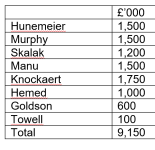
This investment, combined with the increased wage bill is evidence that Tony Bloom did bankroll a serious promotion bid last season.
Financial Fair Play (FFP)
We’re not big fans of FFP here at NSC. For years we’ve pointed out that the rules are open to abuse and the only winners are likely to be cheats and lawyers.
Setting that aside, the maximum allowed FFP loss last season was £13 million, so how did the Albion make a loss of twice that yet comply with the rules?
The answer is that losses for FFP purposes are calculated using different rules to the accounts. Certain costs, such as infrastructure and academy, are excluded when calculating the FFP loss.
We’ve applied an element of guesswork for some figures, as not all are disclosed in the accounts, and have come up with the following.

So the club managed it, just, but we suspect there was not a lot of wiggle room.
Summary
Under almost all other circumstances the Albion would have been promoted, starting the season with a 21 match unbeaten run and finishing it 14 matches unbeaten is unprecedented.
They were unlucky that Burnley managed 23 matches unbeaten to be promoted as Champions, Boro had the benefit of The Complete And Utter Shyster’s decision making, and to lose four players to injury in 50 minutes at Sheffield Wednesday was a tragedy.
The losses incurred are huge, but roughly in line with expectations given what had happened in 2014/15 followed by the investment made in the playing squad in the next two transfer windows.
The future
2016/17 is a massive season for the Albion, with further investment in the squad in the shape of record signing Shane Duffy, Gaeten Bong, Oliver Norwood and Glenn Murray, along with new contracts for Chris Hughton, Solly March, Conor Goldson, Solly March and Beram Kayal, expect wage costs to rise.
Assuming that there are no significant player sales in January 2017, we would therefore expect to see losses of at least £30 million if the club stay in the Championship, and substantially more if the club is promoted to the EPL. This is because Tony Bloom has promised every member of staff, from the tea lady upwards, a bonus should the Albion go up.
Failure to be promoted could cause problems however. Under the latest FFP rules losses are limited to £39 million. Given that we believe the Albion did not have much headroom in 2015/16 to say within the limit, there could be belt tightening or sales of key players to keep to the rules.
Ultimately we all want the club to succeed on the pitch. If that happens then the finances will improve.
For fans who want financial success, the team with the highest profit margin over the last five years is another coastal town beginning with the letter ‘B’, but this time based in Lancashire rather than Sussex. I suspect that this club’s fans are not as appreciative of their chairman as Albion fans are of Tony Bloom though….
That’s what Tony Bloom effectively did for the Albion last season. The club has just announced losses of £25.9 million for the year ended 30 June 2016, compared to £10.4 million the previous season.
However, TB did more than that cover the losses, he lent the club over £34 million in the same period, to take his total investment (in both shares and loans) to just under £252 million.
We’ve taken a look at the accounts in detail, and, thanks to a very old pile of documents coming our way, can compare the financial machine that is the Albion today to some of the pivotal moments in the club’s history.
What becomes increasingly evident is that the normal rules one would apply when assessing a business do not apply in the Championship.
Income
Football clubs get their money from three main sources fans (matchday), TV and radio (broadcasting) and commercial deals/advertising.


Matchday income
A look at the Albion over the last three seasons reveals that matchday income at the Amex appears to have reached a plateau.
The club froze most prices for matches and season ticket holders, and therefore were reliant on either higher attendances or more matches to increase income.
Whilst the football and results from the Albion in 2015/16 were incredible, there was a fan hangover from the previous season, where the club came close to relegation.
Despite the improvement in the quality of football, tickets sold for each game at the Amex fell, albeit by only 0.3%, to 25,583.
Whilst I suspect that tickets for individual matches rose, as more casual fans chose to watch the Albion, this was offset by a reduction in season ticket renewals from 2014/15.
Add to that a reduction in the number of matches hosted at the Amex due to early cup exits, and that results in the fall in matchday income.
The importance of matchday income is shown above. It generates half of the Albion’s turnover, to put this in context, this figure can be as low as 9% for clubs in the Premier League.
This shows the importance of getting both the pricing and the product to the Albion board, as fans contributions are significant. Issues such as transport and catering are ongoing challenges as they act as deterrents to some fans when deciding whether or not to attend individual matches.
One problem in relation to matchday income is that the Amex is effectively only open for 25 days a year in terms of earning money, whereas many costs, such as staff wages, are borne 365 days a year.
This current season (2016/17) the Albion’s great start to the season means they are currently averaging 26,931 fans at the Amex.

We’ve estimated that the club generates an average £18 from each additional matchday ticket sold (remember the club has to pay VAT to the government at 20% and also pay for the travel cost, which is probably £3 per ticket. In addition, some tickets will be sold to concessions, so quoted matchday prices need to be adjusted).
The extra 1,348 tickets being sold each match, over (say) 24 matches at the Amex this season, will therefore generate about £580,000 of extra income. This is equivalent to what Tony Bloom lent to the club in less than a week last season.
Broadcasting income
In the Premier League (EPL) the vast majority of turnover for a provincial club against which the Albion would logically benchmark themselves (Stoke, Swansea, West Brom etc.) comes from TV deals. This can account for up to 80% of turnover.
The new Sky/BT deal covering domestic rights for three seasons commencing 2016/17 is worth over £5,100,000,000 and overseas rights add a further £3 billion to that total, with new deals (such as China) being announced on a regular basis.
This meant that EPL clubs in 2015/16 received a minimum of £66 million, which is set to increase to a minimum of £99 million in 2016/17.
In addition, teams relegated from the EPL are set to receive parachute payments of about £40 million a season, which is why the Albion are at a considerable disadvantage competing against such clubs.
This means promotion is becoming more critical season by season, as parachute payments increase the probability of clubs relegated from the EPL swiftly bouncing back.
The deal signed by the English Football League (EFL) for broadcasting is miniscule compared to the EPL. The Albion’s money is effectively split between a ‘solidarity’ payment from the EPL (which is set to rise in 2016/17 as a side benefit of the new EPL deal) and the distribution of rights for the 72 clubs in the EFL.
The chasm between the two deals is simply due to commercial reasons. Both domestic and overseas armchair fans want to watch ‘big’ teams such as Manchester United, Liverpool and Chelsea. We have to be honest and admit there is limited demand from both viewers and sponsors for Birmingham v Brighton at 5:30 on a Saturday night in December.
Commercial income
I have lumped in with sponsorship deals things such as women’s football, catering/events (the Albion had an effective £400,000 benefit from showing the Rugby Football World Cup last Autumn) and other sundry issues.
For a club the size of the Albion, commercial deals are worth about a quarter of total income. There has been little change from 2015 to 2016 simply because most deals are spread over a number of years.
Furthermore, the poor season in 2014/15 meant that the Albion were not a very attractive prospect for sponsors for the following year, so it would have been difficult to extract extra cash from this source.
Summary
Overall the Albion have done well to increase income, but the disadvantages they have in not receiving parachute payments gives further credence to their efforts to expand income streams through ventures such as the hotel at Falmer.
Wages
It’s no surprise to learn that the main costs of a football club are wages. Tony Bloom backed Chris Hughton last season by agreeing to sign players (see later) and pay them competitive wages for the Championship.
The most striking figure is that the total wages cost rose about a third compared to 2015 to a total of £27.4 million. This means that for every £100 of income generated by the club, they paid out £111 in wages.
This should not however be a huge surprise when you consider that the club signed Hunemeier, Hemed, Skalak, Goldson, Murphy, Knockaert and Manu for significant fees. If you pay large fees for players, then they expect commensurate wages.
In addition the Albion rebuffed Fulham’s £5 million plus bid for Lewis Dunk by granting him a new contract, and this would have come with a significant pay rise as a reward for him staying.
The return of Bobby Zamora would also have increased the wage bill. Whilst Bobby would have been on a fraction of his Premier League wages from earlier in his career, he still would have expected a decent reward for a player of his experience at the top level of football.
Championship wages are high these days for two reasons. Whilst it would be impossible to come close to matching what could be offered by a top level EPL team (the Albion’s total wage bill for all 270 full time employees is approximately equal to what Manchester United pay to the combined earnings of Rooney and Ibrahimovic), the club needs to be able to resist overtures from lower level EPL teams and Championship clubs awash with parachute payments for their star players.
In addition, Championship clubs are willing to spend big because the rewards of promotion are so high. The extra £100 million a season for each season in the EPL is very attractive to club owners, and in some ways is like a winning lottery ticket. However, instead of having a 1 in 140 million chance as you and I have of winning on the National Lottery, there is a 3 in 24 chance of being promoted at the start of each season to win this £100 million. Under those circumstances club chairmen are willing to pay a lot for a ticket to win the prize.
If you think that the Albion wage total is high, then just wait for Middlesbrough to announce their results. They were supposedly paying Downing £50,000 a week and Jordan Rhodes would be on something similar following his £9 million move in January. It was only 18 months ago that Adam Clayton rejected a move to the Albion because ‘Boro had offered him more money. Boro’s wage bill in 2015 was slightly lower than that of the Albion at £20.5 million but I would anticipate this reversing in 2016.
The Championship in 2016 is thus a totally different beast to when the Albion were promoted in 1978/79 to the top division. That season the highest paid player was on £350 a week and the total wage bill at the club was £442,000, less than what the average first team squad member is on at present at the Albion.

Over the 37 years since the Albion were promoted to the old first division in 1978/9, wages have grown by 6,095%.
It would be remiss of us at this stage to not mention executive pay. In any other industry, if a new chief executive was recruited on a salary 3-4 times that of his predecessor, and under the first four years of his tenure delivered record losses of £62 million, then there would be eyebrows raised.
However, as has been mentioned before, Championship level football is not an ordinary business. Paul Barber has been responsible for cutting non-football related costs during this period, and this has enabled the club to stay within Financial Fair play limits.
For this reason his pay is fair as he’s delivered cost savings and allowed managers to have a higher playing budget. In addition the highest paid CEO’s in the EPL are on more than £2 million a year, so Tony Bloom has to pay a significant amount to be competitive.

Eagle eyed fans amongst you will note that David Bellotti was paid £40,000 a year during the final years of the Goldstone. Whilst it is usually wrong to speak ill of the dead, in this case we’re sure an exception is appropriate. Bellotti was responsible for selling the Goldstone for £7 million, and then saw it sold within 12 months for three times that sum.
Losses
Profits and losses are abstract accounting concept, but, put simply, is income less costs. We have slightly tweaked the way the club has set out the numbers simply to strip out the volatile impact of player sales.

Some of the costs above require further explanation. Player amortisation is how clubs deal with transfer fees in terms of impact on profit. If (for example) Shane Duffy cost the club £3.6 million and signed a four-year contract, then £900,000 amortisation (£3.6m/4) is charged against profits for the next four seasons.
The increase of 60% in this figure between 2015 and 2016 reflects the investment in the playing squad. Some players contracts are not amortised. Those who have come through the youth system, such as Dunk and March, and players who have signed on free transfers, such as Zamora, will not have any impact on this total.
Depreciation is similar to amortisation, but relates to the cost of the Amex, the Lancing training facilities and other long term assets. These are not cash costs, but is merely something to keep the accountants happy in spreading the cost of the stadium over the expected period of use.
One area the senior management team focus a lot of time on is cost control. Staff numbers for non-players were static between 2015 and 2016, so it looks as if there is some form of head count control.
If the club can reduce non-footballing costs, then there is more money available to spend on the playing budget. So the club take a very intense line by line approach to all costs, so see if there is scope for savings.
One figure that is significant above is the gain on player sales. If fans are scratching their heads to work out how we sold a player at a profit in 2015/16, the answer is almost certainly Leo Ulloa, despite him leaving the Albion in July 2014.
This is because it appears the club had a clause in the sale contract along the lines of Leicester paying the Albion an extra sum should Leicester avoid relegation in 2015/16, which they of course did with some elan. The gain of £8.7 million in 2014/15 is due to the sales of Leo Ulloa and Will Buckley at prices significantly higher than their value in the accounts.
So although last season (2014/15) the Albion announced a loss of £10.4 million, this was understating their day to day trading losses, which came out at £19.1 million if the player sales were excluded. I think this is a better reflection of the performance as gains on player sales are windfalls and very difficult to budget for.
Total costs, before gains on player sales, therefore topped £52 million, which means that the Albion’s running costs are exceeding £1 million a week.
The increase in losses from 2015 to 2016 can therefore be reconciled as follows:

To give some historical perspective, when the Albion were promoted in 1978/79, they made a profit of £296,000.

Player investment
In 2015/16 Burnley, awash with parachute payments, spent at least £7 million on one player, Andre Gray. Boro, who as we’ve already mentioned, went for broke and bought Rhodes for somewhere between £9-11 million, Downing for £5.5m, Nugent £4m, Stuani £3.5m, a total spend of around £25 million.
The Albion’s total player purchases, whilst a record for the club, came to £9.15 million, spread over a number of purchases.
Whilst the club prefer to keep transfer fees as ‘undisclosed’ in the main, we’ve come up with a rough and ready allocation as follows

This investment, combined with the increased wage bill is evidence that Tony Bloom did bankroll a serious promotion bid last season.
Financial Fair Play (FFP)
We’re not big fans of FFP here at NSC. For years we’ve pointed out that the rules are open to abuse and the only winners are likely to be cheats and lawyers.
Setting that aside, the maximum allowed FFP loss last season was £13 million, so how did the Albion make a loss of twice that yet comply with the rules?
The answer is that losses for FFP purposes are calculated using different rules to the accounts. Certain costs, such as infrastructure and academy, are excluded when calculating the FFP loss.
We’ve applied an element of guesswork for some figures, as not all are disclosed in the accounts, and have come up with the following.

So the club managed it, just, but we suspect there was not a lot of wiggle room.
Summary
Under almost all other circumstances the Albion would have been promoted, starting the season with a 21 match unbeaten run and finishing it 14 matches unbeaten is unprecedented.
They were unlucky that Burnley managed 23 matches unbeaten to be promoted as Champions, Boro had the benefit of The Complete And Utter Shyster’s decision making, and to lose four players to injury in 50 minutes at Sheffield Wednesday was a tragedy.
The losses incurred are huge, but roughly in line with expectations given what had happened in 2014/15 followed by the investment made in the playing squad in the next two transfer windows.
The future
2016/17 is a massive season for the Albion, with further investment in the squad in the shape of record signing Shane Duffy, Gaeten Bong, Oliver Norwood and Glenn Murray, along with new contracts for Chris Hughton, Solly March, Conor Goldson, Solly March and Beram Kayal, expect wage costs to rise.
Assuming that there are no significant player sales in January 2017, we would therefore expect to see losses of at least £30 million if the club stay in the Championship, and substantially more if the club is promoted to the EPL. This is because Tony Bloom has promised every member of staff, from the tea lady upwards, a bonus should the Albion go up.
Failure to be promoted could cause problems however. Under the latest FFP rules losses are limited to £39 million. Given that we believe the Albion did not have much headroom in 2015/16 to say within the limit, there could be belt tightening or sales of key players to keep to the rules.
Ultimately we all want the club to succeed on the pitch. If that happens then the finances will improve.
For fans who want financial success, the team with the highest profit margin over the last five years is another coastal town beginning with the letter ‘B’, but this time based in Lancashire rather than Sussex. I suspect that this club’s fans are not as appreciative of their chairman as Albion fans are of Tony Bloom though….
Last edited:

